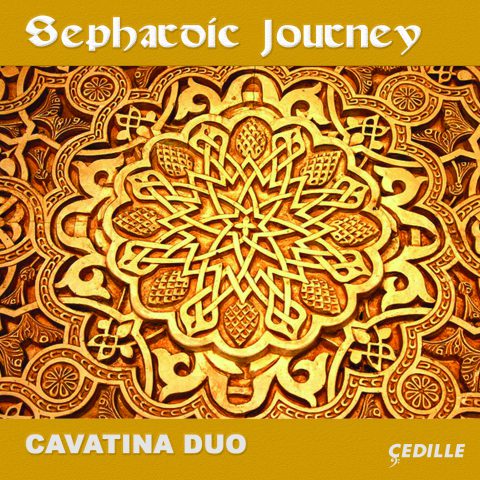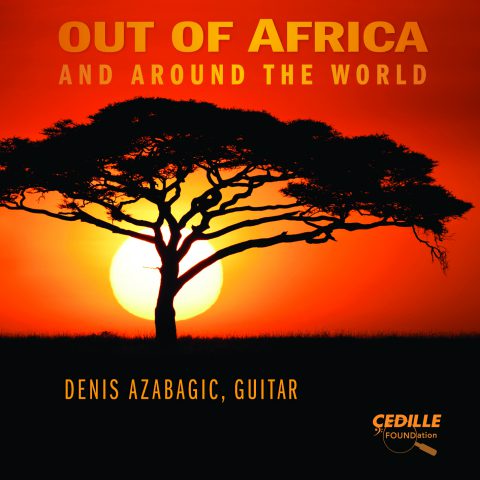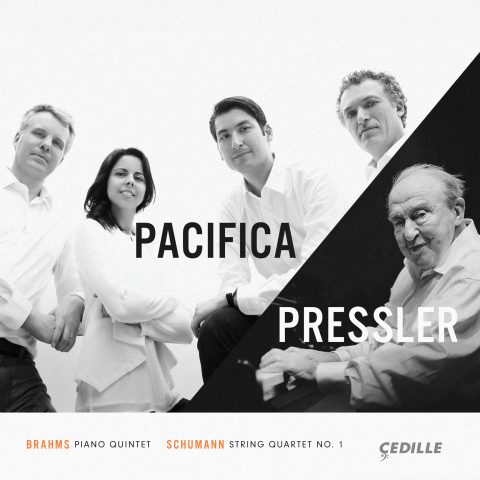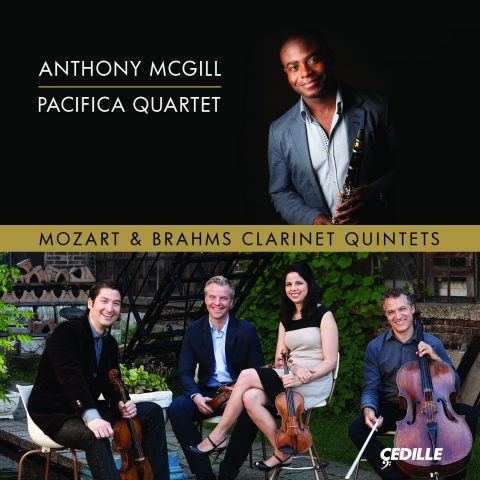| Subtotal | $18.00 |
|---|---|
| Tax | $1.85 |
| Total | $19.85 |
Store
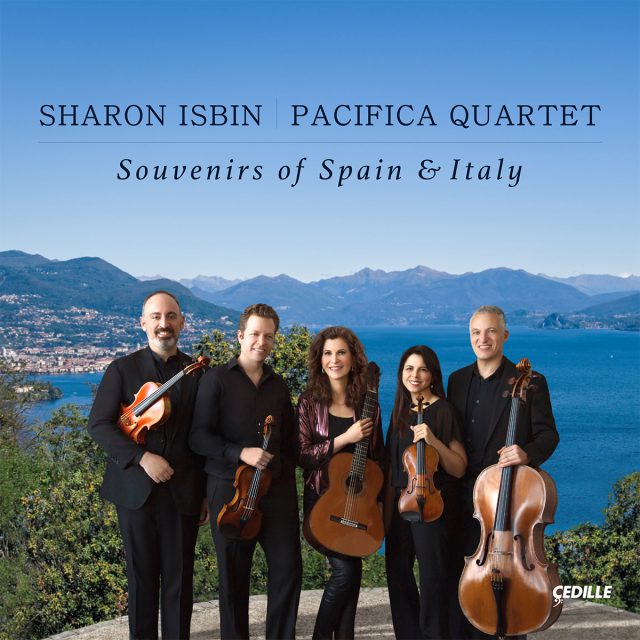
The Grammy Award-winning Pacifica Quartet and multiple Grammy-winning guitarist Sharon Isbin join forces for an uncommon album of music for strings and guitar from the Baroque to the mid-20th century. Souvenirs of Spain & Italy is the first joint recording by these renowned artists and marks Isbin’s Cedille Records debut.
The program spotlights Italian-born composers influenced by Spanish idioms. Mario Castelnuovo-Tedesco’s Quintet for Guitar and String Quartet, Op. 143, is a seldom-heard gem demanding virtuosity from every player. Written for guitarist Andrés Segovia, it’s “an urbane work, rich in vibrant themes and dialogues among individual lines,” critic Allan Kozinn writes in the liner notes. Isbin and the Pacifica play Emilio Pujol’s guitar arrangement of Antonio Vivaldi’s lute Concerto in D Major, RV 93. Isbin’s guitar work in the dreamlike, meditative Largo movement features her own Baroque ornamentation. Luigi Boccherini’s Quintet for Guitar and String Quartet in D Major, G. 448, melds the emerging classical style of late 18th-century Vienna with hints of Spanish flamenco. Spanish composer Joaquín Turina’s string quartet movement, La Oración del Torero, Op. 34, evokes the fervor of a matador’s private prayer before entering the bullring.
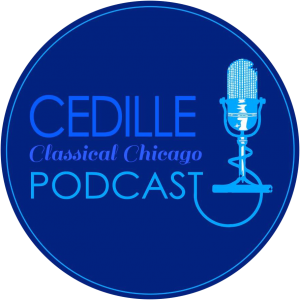
Listen to Jim Ginsburg’s interview
with Sharon Isbin and Brandon Vamos
on Cedille’s Classical Chicago Podcast
Preview Excerpts
MARIO CASTELNUOVO-TEDESCO (1895–1968)
Quintet for Guitar and String Quartet, Op. 143
ANTONIO VIVALDI, ARR. EMILIO PUJOL/ED. SHARON ISBIN
Concerto in D Major, RV 93
JOAQUÍN TURINA
LUIGI BOCCHERINI
Quintet for Guitar and String Quartet in D Major, G. 448
Artists
9: Eduardo Leandro, castanets
Program Notes
Download Album BookletGUITAR QUINTETS
Notes by Allan Kozinn
In its purest form, the classical guitar’s nylon (formerly catgut) strings and medium-sized resonating chamber yielded a sweet, rounded sound — but a soft-spoken one, compared with bowed and blown instruments. As a result, the guitar, in its classical incarnation, has for the most part been a lonely instrument, a solo voice singing a remarkably varied repertory that embraces everything from dolorous introspection to vigorous dance music, but typically on its own. The recording studio, of course, has always been a place where guitarists can redress the balance problems inherent in ensemble music, and relatively recently, guitarists of Sharon Isbin’s generation have been using subtle sound reinforcement technology that has leveled the playing field in the concert hall as well.
But even before the advent of recordings and amplification, brave composers and guitarists (and before them, lutenists) have been intent on creating a concerto and chamber repertory for the instrument, and quite a few have successfully melded the guitar’s timbres with those of orchestral instruments. This recording brings together three notably successful combinations of plucked and bowed strings — and, as a lagniappe of sorts, a 20th century work composed for four lutes, but most frequently heard in its later version for strings, as the Pacific Quartet performs it here.
The Concerto in D major (RV93) is the most enduringly popular of the four chamber works Antonio Vivaldi (1678–1741) composed with the lute as a solo voice, the others being a second concerto, in D minor, and a pair of trio sonatas, in G minor and C major. All but the D minor Concerto were composed while Vivaldi was traveling in Bohemia — most likely in Prague — between 1729 and 1731. It was not published in Vivaldi’s lifetime, but the manuscript survives (it is at the Turin National University Library, in Turin, Italy), showing it to have been scored for two violins, lute and a bass line that would typically have been the foundation of a basso continuo — the flexible support ensemble that usually included a cello, with a harpsichord or theorbo filling out the harmonies. The manuscript also shows a dedication: P S E Il Con: Wrttbij — or, Per Sua Eccellenza Il Conte Wrttbij, most likely Count Johann Joseph von Wrtby, who was known to have been an avid lutenist.
Modern performances often transfer the lute part to the guitar and have the cello hold down the continuo line, without the help of harmony instruments, although period instrument ensembles are increasingly playing the work as scored. The version Sharon Isbin and the Pacific Quartet offer here is by Emilio Pujol, who reassigned the second violin part to the viola, creating a more evenly-balanced ensemble.
Guitar historians and listeners fascinated with the instrument’s modern development will relish the degree to which this edition offers a kind of authenticity that looks back at the guitar world at the turn of the century, when Pujol’s sensibilities were formed during his time as a student of Francisco Tárrega, the last great virtuoso guitarist-composer of the 19th century. Pujol was also an influential teacher — he presided over master classes in Spain nearly until his death, at 94, in 1980 — as well as a pioneering musicologist who rediscovered and transcribed the early repertory of the guitar and its antecedents. Often, as in this case, he struck a balance between fidelity to the original, and revisions that, to his ear, yielded more balanced sound when played on modern instruments.
Instrumentation aside, the work itself is a vital three-movement score, with a pair of Allegro movements surrounding a dreamy Largo in which the guitar’s bittersweet, dotted-note meditation is accompanied by sustained string chords, and is expanded upon deftly by Sharon Isbin in her own ornamentation. The opening Allegro is a modified Rondo movement, with its opening full ensemble figure serving as a Ritornello, and the solo line offering major and minor key elaborations and chromatic climbing figures, all at a lively tempo. And the finale, in a brisk 12/8 meter, has the character of a rustic Italian dance, with the solo line — as in the first movement — elaborating on the rhythmic figures introduced by the full ensemble.
When Vivaldi began his career in 1703 — the year he both took his Holy Orders and became a priest, but also took up his post as maestro di violin at the Pio Ospedale Pietà, an orphanage and girls’ conservatory, in Venice — the lute was very much in vogue as a solo instrument. By the time he wrote his chamber works for the instrument, around 1730, its star was fading. Eventually, it would be supplanted by the more robust guitar, but by 1798, when Luigi Boccherini (1743–1805) wrote his Guitar Quintet No. 4 in D major (G. 448), the guitar was still at its most popular in the land of its birth, Spain — the country where Boccherini worked from 1768 until his death.
The son of a noted cellist and double bassist, Boccherini traveled widely, and his ability to soak up the musical accents of the places he visited — the nascent Classical style in Vienna and hints of flamenco in Spain, for example — helped him develop the suave cosmopolitan style that informs the D major Guitar Quintet. Boccherini studied the cello and composition in Rome before moving to Vienna with his father, who found them both positions in the court orchestra in 1757. He returned to Lucca in 1764, with positions in theatre orchestras and churches, and shortly thereafter he was working in Milan with Giuseppe Sammartini’s orchestra. He toured Europe in 1766 with the violinist and composer Filippo Manfredini, and ended up in Paris, where Boccherini remained for two years, building his reputation as a composer of stylish chamber works.
In Paris, he struck up an acquaintance with the Spanish ambassador to France, who persuaded Boccherini to move to Spain, where he quickly ingratiated himself to the royal family by dedicating a set of quartets to Prince Don Luis, the brother of King Charles III. The prince employed him immediately, in his dual capacity as a virtuoso cellist and as a composer — an appointment he held until the prince’s death, in 1785, whereupon he became chamber music composer to Prince Friedrich Wilhelm of Prussia — a job he was able to meet without relocating from Madrid.
The Guitar Quintet was one of about a dozen he supplied to François de Borgia, the Marquis of Benavente — a Spanish nobleman who played the guitar and wanted versions of some of his favorite Boccherini chamber works with adapted guitar parts. These were, in other words, not newly composed works, but arrangements of existing pieces. In the case of the Guitar Quintet No. 4, the source for the first two movements was the Quintet in D, Op. 10, No. 6 (G. 270, from 1771), with the finale drawn from the Quintet in D, Op. 40, No. 2 (G. 341, from 1788). Thanks to the modern popularity of the guitar, the resulting guitar version, first published in 1925, is far better known now than either of the originals.
It begins with a graceful Pastorale movement, built on a lovely, rocking theme, traded between the strings and the sweetly harmonized guitar line. In the Allegro maestoso, the guitar is in a mostly (although not entirely) accompanimental role, complete with full-bodied strummed passages for emphasis, while violin lines — and Boccherini’s own instrument, the cello — take the lead much of the time.
The third movement begins with a Grave assai. It’s tempting to note that this slow section reprises the gently melancholy spirit of the opening Pastorale, but of course, the movements are taken from different works, composed 17 years apart. And in any case, the main business of the movement is the stunning Fandango, a vigorous Spanish dance in which the guitar moves easily between refined detailing and hard-strumming flamenco effects, while a castanet part further emphasizes the music’s folkloric roots and the strings contribute effects of their own, including glissando passages that underscore the festive spirit.
Mario Castelnuovo-Tedesco’s Quintet for Guitar and String Quartet (Op. 143) comes from a very different world, that of the mid-20th century — although Castelnuovo-Tedesco’s assertion that he was an “anti-modernist” guarantees a certain amount of continuity in that he has maintained his allegiance to tonality and traditional structures.
Castelnuovo-Tedesco (1895–1968) was the scion of a Jewish family that settled in Italy after the expulsion from Spain, in 1492, and often used his heritage as inspiration — for example, in his Violin Concerto No. 2, composed for Jascha Heifetz in 1931. The following year, Castelnuovo-Tedesco met Andrés Segovia, who was at the start of his own career and was encouraging composers to contribute to the guitar’s repertory. Castelnuovo-Tedesco immediately complied, supplying Segovia with the “Variazioni attraverso i secoli (Variations à travers les siècles)” a few months later. Castelnuovo-Tedesco continued to write solo guitar works for the rest his life, as well as one of the first modern concertos for the instrument (in 1939), and the present Quintet — the first contemporary chamber work to put the instrument in the spotlight.
By the time the concerto was complete, Castelnuovo-Tedesco had decided to leave Italy, where his music had been banned, and where the country’s new (1938) racial laws made life untenable. Heifetz sponsored his immigration to the United States, where he settled in Beverly Hills and quickly found work in as a prolific composer of film scores, including those for Tortilla Flat, And Then There Were None, and Gaslight.
The Guitar Quintet had its genesis in another encounter with Segovia, who had come to Los Angeles at the start of 1950 to play the concerto Castelnuovo-Tedesco had written for him in 1939. After the performance, Segovia was invited to perform with the city’s chamber music society. At first, he demurred, citing a paucity of chamber repertory. But never one to let an opportunity slip away, he added that he would accept the engagement if Castelnuovo-Tedesco composed a chamber piece for him. The composer accepted on the spot. By February 7, he had completed the first of the work’s four movements; on March 5, he had completed the full score. A year later, Segovia returned to Los Angeles to play the premiere with the Paganini Quartet.
An urbane work, rich in vibrant themes and dialogues among individual lines, the Quintet is a work Castelnuovo-Tedesco later recalled as “one of my best chamber works, not only as a work for the guitar.” He described the piece at length in his autobiography, Una Vita di Musica: Un libro di recordi (A Life of Music: A Book of Memories, edited by James Westby, 2005):
The quintet has a simple, flowing, almost Schubertian lyricism (and you know how much I love Schubert!). The first movement is particularly Schubertian; the Allegro vivo e schietto is one of the most concise and stringent movements I have ever written. However, the second movement, the “Andante mesto”, is my favorite, with its long and touching melodic phrasing in which a typically Spanish melisma emerges (in the central part); in fact I wrote above it, “Souvenir d’Espagne.” This is followed by a spirited third movement, Scherzo alla Marcia. The Quintet ends with a fiery Finale in 6/8, very contrapuntal but also interrupted, in the middle, with the more languid rhythm of a habanera, another “Souvenir d’Espagne.”
The Spanish composer Joaquín Turina (1882–1949) was another who responded plentifully to Segovia’s call for new works, but La Oración del Torero (The Bullfighter’s Prayer), Op. 34, was not among his guitar pieces. Composed in 1925 and lasting less than ten minutes, it is a moment of distilled fervor — a blend of anxiety and introspection, intended to capture the few moments a bullfighter spends in a small, incense-filled chapel, praying for God’s protection before going out to face the bull.
Turina composed the work for the Quarteto Aguilar, a lute quartet, although the lutes at hand were neither the small Renaissance instrument nor its larger Baroque descendent, but rather, a set of mandolin-like Spanish instruments of different sizes and pitches. Appearing just as Spanish music was buoyed by a wave of nationalism, and suiting that spirit perfectly in both musical accent and subject matter, the Oración was an immediate success. But Turina realized that it would not have a life of its own, internationally, unless he published a version in a more conventional scoring; so in 1936, he reworked the piece, creating editions for string quartet, string orchestra, and piano trio.
Allan Kozinn writes about music and musicians for the Wall Street Journal, The New York Times, Opera News, and other publications.
Album Details
PRODUCER Judith Sherman
ENGINEER Bill Maylone
PRODUCTION ASSISTANT Jeanne Velonis
RECORDED January 19-21, 2019 in Auer Hall, Indiana University, Bloomington, IN
MICROPHONES Sonodore RCM-402, DPA 4006, Sennheiser MKH 800
COVER PHOTO Austin Ward
COVER GRAPHICS Marilynn Hawkridge
PUBLISHERS
Boccherini © 1973 Edizioni Suvini Zerboni
Castelnuovo-Tedesco © 1959 Schott Music, renewed 1987
Turina © 1926 Union Musical Española
Vivaldi © 1957 Editions Max Eschig
Sharon Isbin plays a guitar by Antonius Mueller with Savarez strings.
© 2019 Cedille Records/Cedille Chicago
CDR 90000 190
